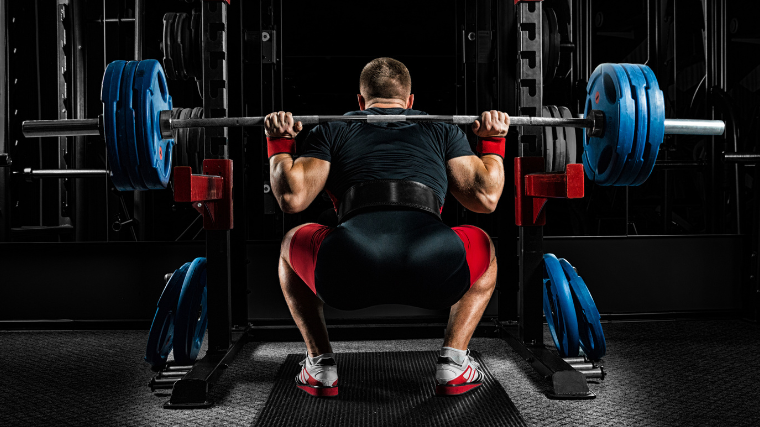Your workouts shouldn’t make you feel like you’re on a scavenger hunt. If you’re ever had to scour a crowded facility, desperately trying to find that one missing cable attachment (seriously, where is it?) you know just how frustrating it can be to not have what you need readily available.
The squat rack can be the answer to your woes and worries. Despite being such a simplistic piece of equipment, a good rack can provide you with the resources you need to effectively train just about every muscle in your body.

If you’re pressed for time (or just love working with the barbell), consolidating your exercise plan into one location can save time, reduce stress, and help you get after your goals just as well — if not better. Here’s how to make the squat rack your ground zero for gains.
- Squat Racks vs. Power Racks
- The Workout
- Who Should Try This Workout
- Benefits of Full-Body Training
- How to Warm Up for Full-Body Training
Squat Racks vs. Power Racks
Before you dive in, you should know that there’s more than one type of rack out there. While most cages or frames meant to house a barbell can be colloquially referred to as squat racks, there is a distinction that merits a mention.
Generally speaking, a squat rack consists of two vertical frames with adjustable hooks for you to set the barbell at various different heights.

A power rack on the other hand is a rectangular cage that you’re meant to lift inside of. Notably, power racks have a vertical bar overhead for you to perform pull-ups from. Many power racks also have safety arms or belts on the sides meant to catch a falling barbell in the event you fail a lift.
The workout in this article is meant to be performed in a power rack, though you may be able to find success with it even if your gym only comes equipped with a conventional squat station.
The Workout
If you’ve decided to seclude yourself to the squat (or power) rack in the corner of your gym, you’ll have to get comfortable with the barbell.
There’s some room for flexibility and the inclusion of bodyweight-only movements, but be aware that this training plan will test your proficiency with the bar above all else.
This three-day routine will incorporate many of the fundamental movement patterns you need to build comprehensive, well-rounded strength and muscle. You can tweak and tailor it to suit your specific needs by kicking up the number of sets or reps you perform.
Day One
- Back Squat: 3 x 5
- Close-Grip Bench Press: 3 x 5
- JM Press: 2 x 8
- Barbell Row: 3 x 6
- Barbell Shrug: 2 x 12
- Weighted Plank: 3 sets of 30 seconds.
Day Two
- Romanian Deadlift: 3 x 5
- Push Press: 3 x 5
- Good Morning: 3 x 8
- Pull-Up: 2 x AMRAP
- Barbell Curl: 3 x 8
Day Three
- Front Squat: 3 x 5
- Barbell Lunge: 2 x 8
- Inverted Row: 3 x 8
- Weighted Push-Up: 2 x AMRAP
- Upright Row: 2 x 12
- Barbell Side Bend: 2 x 12
Even though some of the listed exercises aren’t performed with a barbell by default, you can execute them just fine in a rack.
Inverted rows and even pull-ups can be performed by suspending yourself from the bar while it sits in the rack, and you can hoist a plate onto your back for the planks.
How to Progress
Since you’re doing your entire session in one place with (mostly) one tool, you’ll need to lean on linear progression, RPE-based loading, and exercise substitutions to drive progress.
Your best and safest option is to simply look for conservative increases in weight across at least one exercise per workout. You don’t have to push all your lifts at the same time — if your lower-body movements are cranking but pressing and rowing feels funky, push the squats and try to maintain your upper body strength for the time being.
Additionally, you can also add another element of challenge by modifying your movements. Performing Romanian deadlifts from an elevated surface to elongate the range of motion, or substituting Zercher squats in for your front squats will ante up the challenge without requiring that you slap on another weight plate.
Who Should Try Full-Body Training
There are no frills or fanciness to a three-day, full-body routine. While it does lack the specificity of certain training styles (if you want to be a bodybuilder you should probably look elsewhere), there are some populations that stand to benefit from a barbell-only workout routine.
Beginners
Full-body training is great for beginners because it removes much of the intricacy that comes with designing (or performing) a more specialized routine. When you’re just starting out in the gym, you needn’t worry about choosing between a push-pull workout or an upper-lower split.
Keep it simple, work with the barbell, and the gains will flow.
Those Pressed for Time
While you can certainly hop around the gym and still be efficient, one of the best ways to improve your “gym economy” is to cut down on time spent changing out weights or moving between machines.
You’d be surprised at how much time those tasks add up to. But by making the squat rack the centerpiece of your training, you can freely flow between exercises with almost no downtime — or waiting for a machine to free up.
Amateur Powerlifters
Powerlifting is all about how proficient you are in the back squat, bench press, and deadlift. If you aspire to be a strength athlete but don’t feel ready to tackle a powerlifting-specific program, a full-body routine centered around the barbell can help acclimate you to the rigors of compound lifting.
If You’re Coming Back From a Break
If you’ve been away from the gym for a while, you’ll need to get your sea legs back in the first few weeks of returning to exercise.
A barbell-based full-body routine covers all the big movement patterns you need to readjust to training and won’t bog you down with endless isolation exercises that you’re probably already comfortable with performing.
Benefits of Full-Body Training
Training your body as a unit teaches it to perform as a unit. Specific, isolated work has its place, but there are certain perks to working yourself head to toe that you just can’t get elsewhere.
Teaches Movement Congruity
Your body can work as one large, synchronous unit, or as a series of discrete parts. Compound lifting develops the former and teaches your secondary movers and stabilizers to get in the game even when they aren’t moving the weight.

For example, during the barbell row, your entire posterior chain needs to contract isometrically to maintain a static posture in your hips and trunk. If your hamstrings, glutes, or lower back are weak, you won’t be able to row very much for very long.
The same principle applies on dynamic movements like the push press. Your legs may initiate the drive of the barbell, but you have to smoothly and reliably transfer that force up through your torso and let your arms finish the job.
Saves Time
Dedicated isolation exercises are essential for building up specific parts of your body or addressing weak points. However, the more single-joint exercises you add to your workout, the longer it’ll take.
Conversely, compound lifting does a good job of stimulating multiple muscles or muscle groups simultaneously. You may not be able to fatigue your chest with the bench press as well as you can with the dumbbell flye, but you’ll get the job done.
If you’re on the clock in the gym, an assortment of compound lifts for your upper and lower body will properly fatigue you without slowing down your session.
It’s Beginner-Friendly
On their own, small or single-joint movements are easier to learn for beginners. It’s pretty hard to mess up a dumbbell biceps curl, after all.
However, beginners can easily fall prey to paralysis by analysis or fail to grasp the nuances of programming. In that way, newbies can interfere with their own progress by trying to do too much at once, or use more movements than they need.
[Read More: Best Upper Chest Exercises for Building Muscle]
A full-body routine made up of compound exercises removes many of the potential “user errors” that new gymgoers might accidentally commit without realizing. Learning the technique of the squat, deadlift, or press may take longer individually, but once you’ve got it figured out, you can just work.
How to Warm Up for Full-Body Training
A full-body routine requires a different approach to warming up than you’d do for an intermediate or advanced bodybuilding workout.
Further, with so many big lifts packed into one session, knowing where to direct your efforts in the first fifteen minutes of your workout can pay dividends for the next hour.
Get Some Light Cardio
Before you pick up your first weight, you should perform some kind of activity that elevates your base heart rate. Low-intensity cardiovascular exercise is a great way of doing so, but some light calisthenics will work fine too.
Go for 5 to 10 minutes on a low incline treadmill, stair-stepper, or elliptical before you get to the racks. Alternatively, you could work through a light bodyweight circuit for two or three rounds to get your blood pumping.
Do Dynamic Stretches
Once your heart is (lightly) pumping, you may want to consider some dynamic stretches or drills, especially if your workout is your first form of physical activity on the day.
Your brain needs to ramp up just as much as your heart or muscles do — it’s quite common to feel sluggish or slow in the gym if you’ve been sitting at a desk since you woke up.
Work through 2 to 4 different dynamic drills or stretches to get your nervous system fired up for the session at hand. Burpees, box jumps, cat-camel stretching, or single-leg hip hinges are great options. Anything that challenges your stability, coordination, or power output will do fine.
Perform Practice Reps
If your workout has you squatting, the most appropriate thing you can do before you squat…is to squat. Every compound exercise you perform should come after a few sets of technical work with just the empty barbell.
This is a habit shared by rank beginners and world-class strength athletes alike. Whether you squat 80 pounds or 800, you start with the bar. Practice reps help engrain the technique of the exercise and remind you where to direct your attention.

Perform at least one set of 10-15 practice reps for every compound, barbell-based movement you have to do that day. Focus on the path of the barbell, your breathing habits, and activating the relevant musculature.
Consolidate Your Gains
If you’ve been in the gym for a few years already, you may think that full-body training has exhausted its potential usefulness and that to succeed, you must specialize.
While this is (usually) more true than false, life does get in the way of your gym career from time to time. You may not have the luxury of following a two-hour powerlifting or weightlifting workout plan every day.
Sometimes, your main priority is just getting in the door and getting it done, ideally without traversing your gym’s vast landscape just to have a fulfilling workout. Luckily, you can get your daily dosage of iron all in one place — the squat rack.
Featured Image: Dusan Petkovic / Shutterstock